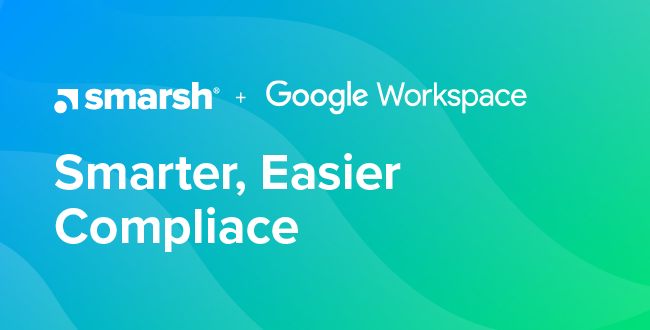Strategic Benefits of a Cloud-Native Archiving Platform
A conversation with Smarsh Chief Product Officer Greg Vesper
As communication methods continue to evolve and remote work becomes the norm, what choices do regulated enterprises make to best position their electronic communications archiving initiatives for the future?
We sat down with Greg Vesper, Chief Product Officer at Smarsh, to discuss the increasing volume and variety of electronic communications in the workplace, and how organizations can future-proof their compliance programs by harnessing public cloud services such as Microsoft Azure and Amazon Web Services (AWS) to power their cloud-native archiving solution. What does he recommend? Be strategic before it’s too late.
An edited transcript of the conversation follows.
Benefits of cloud-native architecture
Product Spotlight: Thanks for joining us, Greg. Can you talk us through the benefits of cloud-native architecture deployed on public cloud services such as Azure and AWS?
Greg Vesper: Of course. What cloud-native gives you is the ability to move away from the single points of failure of traditional enterprise architectures. Cloud-native is something that began with the big data platforms pioneered by Google, where you had horizontally scalable designs and services on top of scalable data repositories. This allowed the services to flexibly increase storage and compute capacity by adding more machines, rather than always trying to build a more powerful (and expensive) machine.
In the case of Smarsh, we don't ever have to worry about the continuous upgrades that happen on the hardware itself. Whether it's network, storage or computing, public cloud service providers are continually updating their infrastructure to keep it current. This allows Smarsh to focus on our unique software services and providing customers with the best possible products, while Microsoft and Amazon take care of ensuring the quality of service necessary for a mission-critical application like archiving.
To be clear, any legacy software provider can deploy their code on Azure or AWS. But you won’t get the horizontal scale, high performance and the triple-active redundancy that a cloud-native architecture offers. You have to build a cloud-native application from the ground up to take advantage of the scalability, performance and high availability of public cloud services. No one else in our competitive space can offer this feature currently — no one has made this level of investment.
The unique advantage of triple-active redundancy
Product Spotlight: A cloud-native archive is unique in the Enterprise Information Archiving space. Tell us more about triple-active redundancy and how this provides a strategic advantage for the customer.
Greg Vesper: Whether it's for routine, day-to-day compliance, or whether it's for some episodic e-discovery and gathering of data for a very specific business driver, such as an audit, inspection or litigation, gathering and organizing content is important and time-sensitive. Therefore, the quality and the availability of the service become critical for the global enterprise, and this is where cloud infrastructures like AWS and Azure demonstrate the value and possibility of high availability.
When Smarsh deploys on Azure or AWS, it’s what we call a “triple-active” deployment. We deploy our archiving software across three different, geographically dispersed data centers, called Availability Zones (AZs). All three of those AZs are actively running the Smarsh software simultaneously. If one of the AZs were to ever go down, the application would not lose dial tone, it would not lose data. Your data and your ability to log-in and use the software would be 100% intact.
This kind of deployment has never been possible until we got into the realm of cloud infrastructures like AWS and Azure. It's completely new. That's an enormous advantage, not just for the high availability, but in terms of the business continuity demands.
In fact, a lot of the opportunities that we have as a business are with clients who have backed themselves into the corner of building out massively expensive multi-petabyte, on-prem infrastructure with single points of failure, and don’t have an easy way out.
Communications archiving as a strategic asset
Product Spotlight: Why should a business consider its electronic communications archive to be a strategic asset?
Greg Vesper: When we were building the Enterprise Archive, we looked to the future. We were driven by a desire to create a scalable content platform for any and all new communications channels, accessible via APIs. This allows you to enrich that content, adding additional layers of metadata around a message. But it also allows you to enable the content, not just for archiving retention or e-discovery or supervision, but for whatever else you might want to do with some of your most valuable data: the communications of your employees. This gets particularly exciting when you consider emerging advances in the areas of machine learning and communications intelligence. The sky is the limit!
Product Spotlight: Any last words of advice for organizations that are examining their commitment to a legacy archiving infrastructure?
Greg Vesper: The main takeaway that I would love for people to have is to think strategically. Where will you and your enterprise be a year from now? Two years from now? Three? Look at the explosion of data. If you build your compliance ecosystem on the wrong foundation, it will create a problem that will never go away. You will have to fix it eventually. So think strategically, think deeply, and solve tomorrow’s problem today.
Share this post!
Smarsh Blog
Our internal subject matter experts and our network of external industry experts are featured with insights into the technology and industry trends that affect your electronic communications compliance initiatives. Sign up to benefit from their deep understanding, tips and best practices regarding how your company can manage compliance risk while unlocking the business value of your communications data.




Subscribe to the Smarsh Blog Digest
Subscribe to receive a monthly digest of articles exploring regulatory updates, news, trends and best practices in electronic communications capture and archiving.
Smarsh handles information you submit to Smarsh in accordance with its Privacy Policy. By clicking "submit", you consent to Smarsh processing your information and storing it in accordance with the Privacy Policy and agree to receive communications from Smarsh and its third-party partners regarding products and services that may be of interest to you. You may withdraw your consent at any time by emailing privacy@smarsh.com.
FOLLOW US